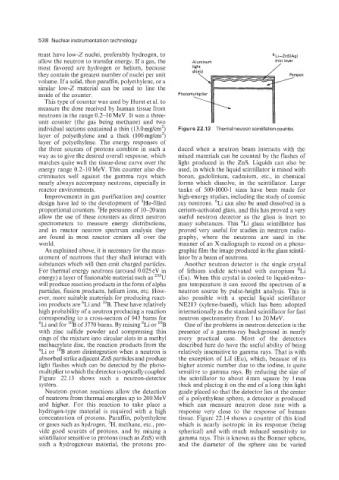Page 556 - Instrumentation Reference Book 3E
P. 556
538 Nuclear instrumentation technology
must have low-2 nuclei, preferably hydrogen, to 6Li-ZnS(Ag)
allow the neutron to transfer energy. If a gas, the Aluminum thin layer
most favored are hydrogen or helium, because light /
they contain the greatest number of nuclei per unit
volume. If a solid, then paraffin, polyethylene, or a
similar low-Z material can be used to line the
inside of the counter.
This type of counter was used by Hurst et al. to
measure the dose received by human tissue from
neutrons in the range 0.2-10 MeV. It was a three-
unit counter (the gas being methane) and two
individual sections contained a thin (13.0 mg/cm2) Figure 22.13 Thermal neutron scintillation counter.
layer of polyethylene and a thick (100 mg/cm')
layer of polyethylene. The energy responses of
the three sources of protons combine in such a duced when a neutron beam interacts with the
way as to give the desired overall response, which mixed materials can be counted by the flashes of
matches quite well the tissue-dose curve over the light produced in the ZnS. Liquids can also be
energy range 0.2-10 MeV. This counter also dis- used, in which the liquid scintillator is mixed with
criminates well against the gamma rays which boron, gadolinium, cadmium, etc., in chemical
nearly always accompany neutrons, especially in forms which dissolve, in the scintillator. Large
reactor environments. tanks of 500-1000-1 sizes have been made for
Improvements in gas purification and counter high-energy studies, including the study of cosmic
design have led to the development of 3He-filled ray neutrons. 6Li can also be used dissolved in a
proportional counters. 3He pressures of 10-20 atm cerium-activated glass, and this has proved a very
allow the use of these counters as direct neutron useful neutron detector as the glass is inert to
spectrometers to measure energy distributions, many substances. This 6Li glass scintillator has
and in reactor neutron spectrum analysis they proved very useful for studies in neutron radio-
are found in most reactor centers all over the graphy, where the neutrons are used in the
world. manner of an X-radiograph to record on a photo-
As explained above, it is necessary for the meas- graphic film the image produced in the glass scintil-
urement of neutrons that they shall interact with lator by a beam of neutrons.
substances which will then emit charged particles. Another neutron detector is the single crystal
For thermal energy neutrons (around 0.025 eV in of lithium iodide activated with europium 6Li
energy) a layer of fissionable material such as 235U (Eu). When this crystal is cooled to liquid-nitro-
will produce reaction products in the form of alpha gen temperature it can record the spectrum of a
particles, fission products, helium ions, etc. How- neutron source by pulse-height analysis. This is
ever, more suitable materials for producing react- also possible with a special liquid scintillator
ion products are 6Li and 'OB. These have relatively NE21 3 (xylene-based), which has been adopted
high probability of a neutron producing a reaction internationally as the standard scintillator for fast
corresponding to a cross-section of 945 barns for neutron spectrometry from 1 to 20 MeV.
6. One of the problems in neutron detection is the
LI and for 'OB of 3770 barns. By mixing 6Li or 'OB
with zinc sulfide powder and compressing thin presence of a gamma-ray background in nearly
rings of the mixture into circular slots in a methyl every practical case. Most of the detectors
x
methacr late disc, the reaction products from the described here do have the useful ability of being
6Li or B atom disintegration when a neutron is relatively insensitive to gamma rays. That is with
absorbed strike adjacent ZnS particles and produce the exception of LiI (ELI), which, because of its
light flashes which can be detected by the photo- higher atomic number due to the iodine, is quite
multiplier to which the detector is optically coupled. sensitive to gamma rays. By reducing the size of
Figure 22.13 shows such a neutron-detector the scintillator to about 4mm square by 1 mm
system. thick and placing it on the end of a long thin light
Neutron-proton reactions allow the detection guide placed so that the detector lies at the center
of neutrons from thermal energies up to 200 MeV of a polyethylene sphere, a detector is produced
and higher. For this reaction to take place a which can measure neutron dose rate with a
hydrogen-type material is required with a high response very close to the response of human
concentration of protons. Paraffin, polyethylene tissue. Figure 22.14 shows a counter of this kind
or gases such as hydrogen, 3H. methane, etc., pro- which is nearly isotropic in its response (being
vide good sources of protons, and by mixing a spherical) and with much reduced sensitivity to
scintillator sensitive to protons (such as ZnS) with gamma rays. This is known as the Bonner sphere,
such a hydrogenous material, the protons pro- and the diameter of the sphere can be varied

